Recent Developments of Dual-Band Doherty Power Amplifiers for Upcoming Mobile Communications Systems
Abstract
1. Introduction
2. Classical Doherty Power Amplifier Operation
- Z1: the impedance seen by the main amplifier
- ZT: transmission line characteristic impedance
- RL: the load
- : the impedance seen by the auxiliary amplifier
- : the current after the λ/4 transmission line
- : current of the auxiliary amplifier
3. Dual-Band Doherty Power Amplifier
3.1. Dual-Band DPA Problems and Challenges
3.2. Π-And T-Networks for Dual-Band DPA
3.3. Offset Lines in Dual-Band Doherty Power Amplifier
3.4. Impedance Modification for Dual-Band DPA
3.5. Dual-Band Design Improvements
3.6. Tri-Band and Quad-Band DPA
3.7. Linearization of Dual-Band DPA
4. Conclusions
Author Contributions
Funding
Acknowledgments
Conflicts of Interest
References
- Cripps, S.C. RF Power Amplifiers for Wireless Communications; Artech House: Norwood, MA, USA, 2006. [Google Scholar]
- Kerhervé, E.; Belot, D. Linearization and Efficiency Enhancement Techniques for Silicon Power Amplifiers: From RF to mmW; Elsevier Science: New York, NY, USA, 2015. [Google Scholar]
- Colantonio, P.; Giannini, F.; Limiti, E. High Efficiency RF and Microwave Solid State Power Amplifiers; John Wiley & Sons Ltd.: West Suss, UK, 2009. [Google Scholar]
- Camarchia, V.; Pirola, M.; Quaglia, R.; Jee, S.; Cho, Y.; Kim, B. The Doherty Power Amplifier: Review of Recent Solutions and Trends. IEEE Trans. Microw. Theory Tech. 2015, 63, 559–571. [Google Scholar] [CrossRef]
- Doherty, W.H. A new high-efficiency power amplifier for modulated waves. Bell Syst. Tech. J. 1936, 15, 469–475. [Google Scholar] [CrossRef]
- Kim, H.; Seo, C. Improvement of Power Added Efficiency and Linearity in Doherty Amplifier using Dual Bias Control and Photonic Band-Gap Structure. In Proceedings of the 2007 Asia-Pacific Microwave Conference, Bangkok, Thailand, 11–14 December 2007; pp. 1–4. [Google Scholar]
- Li, X.; Chen, W.; Zhang, Z.; Feng, Z.; Tang, X.; Mouthaan, K. A concurrent dual-band doherty power amplifier. In Proceedings of the 2010 Asia-Pacific Microwave Conference, Yokohama, Japan, 7–10 December 2010; pp. 654–657. [Google Scholar]
- Saad, P.; Piazzon, L.; Colantonio, P.; Moon, J.; Giannini, F.; Andersson, K.; Kim, B.; Fager, C. Multi-band/multi-mode and efficient transmitter based on a Doherty Power Amplifier. In Proceedings of the 2012 42nd European Microwave Conference, Amsterdam, The Netherlands, 29 October–1 November 2012; pp. 1031–1034. [Google Scholar]
- Gustafsson, D.; Andersson, C.M.; Fager, C. A Modified Doherty Power Amplifier With Extended Bandwidth and Reconfigurable Efficiency. IEEE Trans. Microw. Theory Tech. 2013, 61, 533–542. [Google Scholar] [CrossRef]
- Barakat, A.; Thian, M.; Fusco, V.; Bulja, S.; Guan, L. Toward a More Generalized Doherty Power Amplifier Design for Broadband Operation. IEEE Trans. Microw. Theory Tech. 2017, 65, 846–859. [Google Scholar] [CrossRef]
- Lin, J.; Xie, Z. Analysis and Design of a High Efficient Dual-Frequency Doherty Power Amplifier. In Proceedings of the 2018 International Conference on Microwave and Millimeter Wave Technology (ICMMT), Chengdu, China, 7–11 May 2018; pp. 1–3. [Google Scholar]
- Chen, X.; Chen, W.; Huang, F.; Ghannouchi, F.M.; Feng, Z.; Liu, Y. Systematic Crest Factor Reduction and Efficiency Enhancement of Dual-Band Power Amplifier Based Transmitters. IEEE Trans. Broadcast. 2017, 63, 111–122. [Google Scholar] [CrossRef]
- Kelly, N.; Cao, W.; Zhu, A. Preparing Linearity and Efficiency for 5G: Digital Predistortion for Dual-Band Doherty Power Amplifiers with Mixed-Mode Carrier Aggregation. IEEE Microw. Mag. 2017, 18, 76–84. [Google Scholar] [CrossRef]
- Chen, W.; Chen, X.; Zhang, S.; Feng, Z. Energy-efficient concurrent dual-band transmitter for multistandard wireless communications. In Proceedings of the 2014 Asia-Pacific Microwave Conference, Sendai, Japan, 4–7 November 2014; pp. 558–560. [Google Scholar]
- Chen, X.; Chen, W.; Gongzhe, S.; Ghannouchi, F.M.; Feng, Z. A concurrent dual-band 1.9–2.6-GHz Doherty power amplifier with Intermodulation impedance tuning. In Proceedings of the 2014 IEEE MTT-S International Microwave Symposium (IMS2014), Tampa, FL, USA, 1–6 June 2014; pp. 1–4. [Google Scholar]
- GSMA. 5G Spectrum GSMA Public Policy Position. Available online: https://www.gsma.com/latinamerica/5g-spectrum-gsma-public-policy-position/ (accessed on 15 February 2019).
- Yin, Y.; Xiong, L.; Zhu, Y.; Chen, B.; Min, H.; Xu, H. A compact dual-band digital doherty power amplifier using parallel-combining transformer for cellular NB-IoT applications. In Proceedings of the 2018 IEEE International Solid-State Circuits Conference (ISSCC), San Francisco, CA, USA, 11–15 February 2018; pp. 408–410. [Google Scholar]
- Liu, M.; Golestaneh, H.; Boumaiza, S. A concurrent 2.15/3.4 GHz dual-band Doherty power amplifier with extended fractional bandwidth. In Proceedings of the 2016 IEEE MTT-S International Microwave Symposium (IMS), San Francisco, CA, USA, 22–27 May 2016; pp. 1–3. [Google Scholar]
- Shao, J.; Poe, D.; Ren, H.; Arigong, B.; Zhou, M.; Ding, J.; Zhou, R.; Kim, H.S.; Zhang, H. Dual-band microwave power amplifier design using GaN transistors. In Proceedings of the 2014 IEEE 57th International Midwest Symposium on Circuits and Systems (MWSCAS), College Station, TX, USA, 3–6 August 2014; pp. 559–562. [Google Scholar]
- Ghannouchi, F.M.; Rawat, K. Doherty power amplifiers in software radio systems. In Proceedings of the 2011 XXXth URSI General Assembly and Scientific Symposium, Istanbul, Turkey, 13–20 August 2011; pp. 1–4. [Google Scholar]
- Park, J.; Yook, J.; Kim, Y.; Lee, C.H. Dual-band switching Doherty power amplifier using phase shifter composed of PIN diode. In Proceedings of the 2011 6th European Microwave Integrated Circuit Conference, Manchester, UK, 10–11 October 2011; pp. 300–303. [Google Scholar]
- Bathich, K.; Gruner, D.; Boeck, G. Analysis and design of dual-band GaN HEMT based Doherty amplifier. In Proceedings of the 2011 6th European Microwave Integrated Circuit Conference, Manchester, UK, 10–11 October 2011; pp. 248–251. [Google Scholar]
- Xiang, L.; Wenhua, C.; Zisheng, L.; Zhenghe, F.; Yaqin, C.; Ghannouchi, F.M. Design of dual-band multi-way Doherty power amplifiers. In Proceedings of the 2012 IEEE/MTT-S International Microwave Symposium Digest, Montreal, QC, Canada, 17–22 June 2012; pp. 1–3. [Google Scholar]
- Vizmuller, P. RF Design Guide: Systems, Circuits, and Equations; Artech House: Norwood, MA, USA, 1995. [Google Scholar]
- Saad, P.; Colantonio, P.; Piazzon, L.; Giannini, F.; Andersson, K.; Fager, C. Design of a Concurrent Dual-Band 1.8–2.4-GHz GaN-HEMT Doherty Power Amplifier. IEEE Trans. Microw. Theory Tech. 2012, 60, 1840–1949. [Google Scholar] [CrossRef]
- Wang, G.; Zhao, L.; Szymanowski, M. A Doherty amplifier for TD-SCDMA base station applications based on a single packaged dual-path integrated LDMOS power transistor. In Proceedings of the 2010 IEEE MTT-S International Microwave Symposium, Anaheim, CA, USA, 23–28 May 2010; pp. 1512–1515. [Google Scholar]
- Abdulkhaleq, A.M.; Al-Yasir, Y.; Ojaroudi Parchin, N.; Brunning, J.; McEwan, N.; Rayit, A.; Abd-Alhameed, R.A.; Noras, J.; Abduljabbar, N. A 70-W Asymmetrical Doherty Power Amplifier for 5G Base Stations. In Proceedings of the Broadband Communications, Networks, and Systems, Faro, Portugal, 19–20 September 2018; pp. 446–454. [Google Scholar]
- Monzon, C. A small dual-frequency transformer in two sections. IEEE Trans. Microw. Theory Tech. 2003, 51, 1157–1161. [Google Scholar] [CrossRef]
- Colantonio, P.; Feudo, F.; Giannini, F.; Giofrè, R.; Piazzon, L. Design of a dual-band GaN Doherty amplifier. In Proceedings of the 18th International Conference on Microwaves, Radar and Wireless Communications, Vilnius, Lithuania, 14–16 June 2010; pp. 1–4. [Google Scholar]
- Chen, W.; Chen, X.; Zhang, S.; Feng, Z. Energy-efficient power amplifier techniques for TD-SCDMA and TD-LTE multi-standard wireless communications. In Proceedings of the 2014 XXXIth URSI General Assembly and Scientific Symposium (URSI GASS), Beijing, China, 16–23 August 2014; pp. 1–4. [Google Scholar]
- Grebennikov, A.; Wong, J. A Dual-Band Parallel Doherty Power Amplifier for Wireless Applications. IEEE Trans. Microw. Theory Tech. 2012, 60, 3214–3222. [Google Scholar] [CrossRef]
- Yang, Z.; Li, M.; Yao, Y.; Dai, Z.; Li, T.; Jin, Y. Design of Concurrent Dual-Band Continuous Class-J Mode Doherty Power Amplifier With Precise Impedance Terminations. IEEE Microw. Wirel. Compon. Lett. 2019, 29, 348–350. [Google Scholar] [CrossRef]
- Chuang, M. Dual-Band Impedance Transformer Using Two-Section Shunt Stubs. IEEE Trans. Microw. Theory Tech. 2010, 58, 1257–1263. [Google Scholar] [CrossRef]
- Ren, H.; Shao, J.; Arigong, B.; Zhou, M.; Fu, S.; Ding, J.; Kim, H.; Zhang, H. Simplified Doherty power amplifier structures. In Proceedings of the 2015 Texas Symposium on Wireless and Microwave Circuits and Systems (WMCS), Waco, TX, USA, 23–24 April 2015; pp. 1–3. [Google Scholar]
- Jee, S.; Yunsik, P.; Cho, Y.; Lee, J.; Seokhyeon, K.; Bumman, K. A highly linear dual-band Doherty power amplifier for femto-cell base stations. In Proceedings of the 2015 IEEE MTT-S International Microwave Symposium, Phoenix, AZ, USA, 17–22 May 2015; pp. 1–4. [Google Scholar]
- Lv, G.; Chen, W.; Liu, X.; Feng, Z. A Dual-Band GaN MMIC Power Amplifier With Hybrid Operating Modes for 5G Application. IEEE Microw. Wirel. Compon. Lett. 2019, 29, 228–230. [Google Scholar] [CrossRef]
- Lv, G.; Chen, W.; Chen, X.; Ghannouchi, F.M.; Feng, Z. A Compact Ka/Q Dual-Band GaAs MMIC Doherty Power Amplifier With Simplified Offset Lines for 5G Applications. IEEE Trans. Microw. Theory Tech. 2019, 1–12. [Google Scholar] [CrossRef]
- Moon, J.; Kim, J.; Kim, I.; Kim, B. A Wideband Envelope Tracking Doherty Amplifier for WiMAX Systems. IEEE Microw. Wirel. Compon. Lett. 2008, 18, 49–51. [Google Scholar] [CrossRef]
- Qureshi, J.H.; Nan, L.; Neo, E.; Rijs, F.V.; Blednov, I.; de Vreede, L. A wide-band 20W LDMOS Doherty power amplifier. In Proceedings of the 2010 IEEE MTT-S International Microwave Symposium, Anaheim, CA, USA, 23–28 May 2010; p. 1. [Google Scholar]
- Sarkeshi, M.; Leong, O.B.; van Roermund, A. A novel Doherty amplifier for enhanced load modulation and higher bandwidth. In Proceedings of the 2008 IEEE MTT-S International Microwave Symposium Digest, Atlanta, GA, USA, 15–20 June 2008; pp. 763–766. [Google Scholar]
- Barthwal, A.; Ajmera, G.; Rawat, K.; Basu, A.; Koul, S.K. Design scheme for dual-band three stage Doherty Power Amplifiers. In Proceedings of the 2014 IEEE International Microwave and RF Conference (IMaRC), Bangalore, India, 15–17 December 2014; pp. 80–83. [Google Scholar]
- Liu, M.; Fang, X.; Huang, H.; Boumaiza, S. Dual-band 3-way Doherty Power Amplifier with Extended Back-off Power and Bandwidth. IEEE Trans. Circuits Syst. II Express Briefs 2019, 1. [Google Scholar] [CrossRef]
- Li, X.; Chen, W.; Feng, Z.; Ghannouchi, F.M. Design of dual-band tri-way GaN doherty power amplifier with frequency dependent power division. Electron. Lett. 2012, 48, 797–798. [Google Scholar] [CrossRef]
- Chen, W.; Zhang, S.; Liu, Y.; Ghannouchi, F.M. A Concurrent Dual-Band Uneven Doherty Power Amplifier with Frequency-Dependent Input Power Division. IEEE Trans. Circuits Syst. I Regul. Pap. 2014, 61, 552–561. [Google Scholar] [CrossRef]
- Nick, M.; Mortazawi, A. Adaptive Input-Power Distribution in Doherty Power Amplifiers for Linearity and Efficiency Enhancement. IEEE Trans. Microw. Theory Tech. 2010, 58, 2764–2771. [Google Scholar] [CrossRef]
- Abadi, M.N.A.; Golestaneh, H.; Sarbishaei, H.; Boumaiza, S. An extended bandwidth Doherty power amplifier using a novel output combiner. In Proceedings of the 2014 IEEE MTT-S International Microwave Symposium (IMS2014), Tampa, FL, USA, 1–6 June 2014; pp. 1–4. [Google Scholar]
- Carrubba, V.; Ture, E.; Maroldt, S.; Mußer, M.; Raay, F.V.; Quay, R.; Ambacher, O. A dual-band UMTS/LTE highly power-efficient Class-ABJ Doherty GaN PA. In Proceedings of the 2015 European Microwave Conference (EuMC), Paris, France, 7–10 September 2015; pp. 1164–1167. [Google Scholar]
- Carrubba, V.; Ture, E.; Maroldt, S.; Mußer, M.; Raay, F.V.; Quay, R.; Ambacher, O. A dual-band UMTS/LTE highly power-efficient class-ABJ Doherty GaN PA. In Proceedings of the 2015 10th European Microwave Integrated Circuits Conference (EuMIC), Paris, France, 7–8 September 2015; pp. 313–316. [Google Scholar]
- Kalyan, R.; Rawat, K.; Koul, S.K. Design of reconfigurable concurrent dual-band quarter-wave transformer with application of power combiner/divider. In Proceedings of the 2015 IEEE MTT-S International Microwave and RF Conference (IMaRC), Hyderabad, India, 10–12 December 2015; pp. 169–172. [Google Scholar]
- Kalyan, R.; Rawat, K.; Koul, S.K. Design of reconfigurable concurrent dual-band power amplifiers using reconfigurable concurrent dual-band matching network. In Proceedings of the 2016 IEEE MTT-S International Wireless Symposium (IWS), Shanghai, China, 14–16 March 2016; pp. 1–4. [Google Scholar]
- Lahiri, S.K.; Saha, H.; Kundu, A. RF MEMS SWITCH: An overview at- a-glance. In Proceedings of the 2009 4th International Conference on Computers and Devices for Communication (CODEC), Kolkata, India, 14–16 December 2009; pp. 1–5. [Google Scholar]
- Fan, M.; Yu, C.; Yu, Q.; Liu, Y. Design of a dual-band Doherty power amplifier utilizing improved combiner. In Proceedings of the 2016 IEEE International Conference on Computational Electromagnetics (ICCEM), Guangzhou, China, 23–25 February 2016; pp. 313–315. [Google Scholar]
- Kalyan, R.; Rawat, K.; Koul, S.K. Reconfigurable and Concurrent Dual-Band Doherty Power Amplifier for Multiband and Multistandard Applications. IEEE Trans. Microw. Theory Tech. 2017, 65, 198–208. [Google Scholar] [CrossRef]
- Taghian, F.; Abdipour, A.; Mohammadi, A.; Roodaki, P.M. Design and nonlinear analysis of a dual-band Doherty power amplifier for ISM and LMDS applications. In Proceedings of the 2011 IEEE Applied Electromagnetics Conference (AEMC), Kolkata, India, 18–22 December 2011; pp. 1–4. [Google Scholar]
- Kalyan, R.; Rawat, K.; Koul, S.K. A Digitally Assisted Dual-Input Dual-Band Doherty Power Amplifier With Enhanced Efficiency and Linearity. IEEE Trans. Circuits Syst. II Express Briefs 2019, 66, 297–301. [Google Scholar] [CrossRef]
- Nghiem, X.A.; Negra, R. Design of a concurrent quad-band GaN-HEMT Doherty power amplifier for wireless applications. In Proceedings of the 2013 IEEE MTT-S International Microwave Symposium Digest (MTT), Seattle, WA, USA, 2–7 June 2013; pp. 1–4. [Google Scholar]
- Li, X.; Helaoui, M.; Ghannouchi, F.; Chen, W. A Quad-Band Doherty Power Amplifier Based on T-Section Coupled Lines. IEEE Microw. Wirel. Compon. Lett. 2016, 26, 437–439. [Google Scholar] [CrossRef]
- Nghiem, X.A.; Negra, R. Novel design of a concurrent tri-band GaN-HEMT Doherty power amplifier. In Proceedings of the 2012 Asia Pacific Microwave Conference Proceedings, Kaohsiung, Taiwan, 4–7 December 2012; pp. 364–366. [Google Scholar]
- Rawat, K.; Gowrish, B.; Ajmera, G.; Kalyan, R.; Basu, A.; Koul, S.; Ghannouchi, F.M. Design strategy for tri-band Doherty power amplifier. In Proceedings of the WAMICON 2014, Tampa, FL, USA, 6 June 2014; pp. 1–3. [Google Scholar]
- Giofré, R.; Costanzo, F.; Vikraman, D.N.M.; Colantonio, P.; Giannini, F. Designing a tri-band concurrent Doherty power amplifier. In Proceedings of the 2015 Integrated Nonlinear Microwave and Millimetre-wave Circuits Workshop (INMMiC), Taormina, Italy, 1–2 October 2015; pp. 1–3. [Google Scholar]
- Yanduru, N.K.; Jeckeln, E.; Monroe, R.; Brobston, M. 50W GaN based multi-band Doherty amplifier proof of concept for LTE with 48% efficiency. In Proceedings of the WAMICON 2014, Tampa, FL, USA, 6 June 2014; pp. 1–3. [Google Scholar]
- Blednov, I. Wideband 3 way Doherty RFIC with 12 dB back-off power range. In Proceedings of the 2016 11th European Microwave Integrated Circuits Conference (EuMIC), London, UK, 3–4 October 2016; pp. 17–20. [Google Scholar]
- Rawat, K.; Ghannouchi, F.M. Design Methodology for Dual-Band Doherty Power Amplifier with Performance Enhancement Using Dual-Band Offset Lines. IEEE Trans. Ind. Electron. 2012, 59, 4831–4842. [Google Scholar] [CrossRef]
- Chen, W.; Bassam, S.A.; Li, X.; Liu, Y.; Rawat, K.; Helaoui, M.; Ghannouchi, F.M.; Feng, Z. Design and Linearization of Concurrent Dual-Band Doherty Power Amplifier With Frequency-Dependent Power Ranges. IEEE Trans. Microw. Theory Tech. 2011, 59, 2537–2546. [Google Scholar] [CrossRef]
- Pang, J.; He, S.; Dai, Z.; Huang, C.; Peng, J.; You, F. Novel design of highly-efficient concurrent dual-band GaN Doherty power amplifier using direct-matching impedance transformers. In Proceedings of the 2016 IEEE MTT-S International Microwave Symposium (IMS), San Francisco, CA, USA, 22–27 May 2016; pp. 1–4. [Google Scholar]
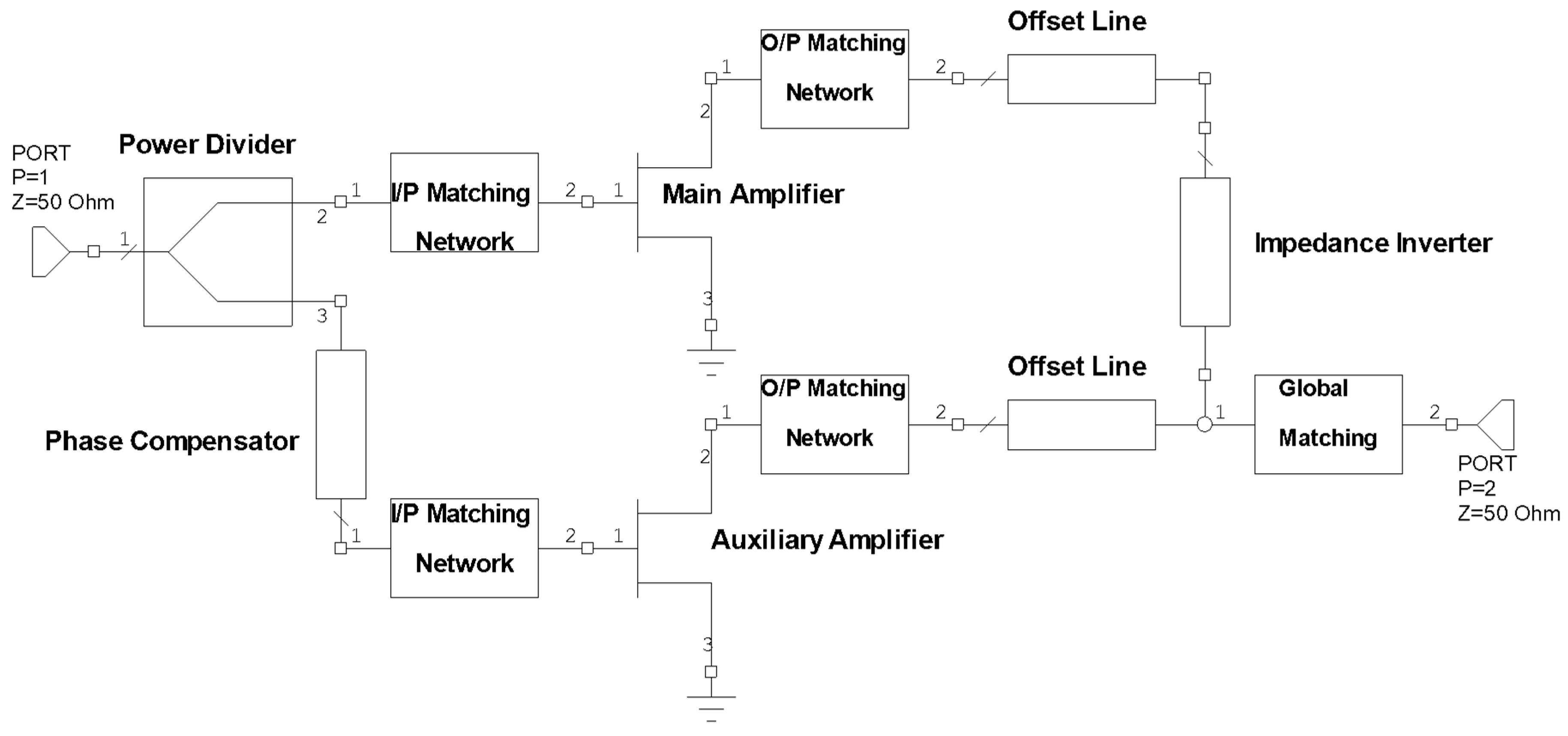
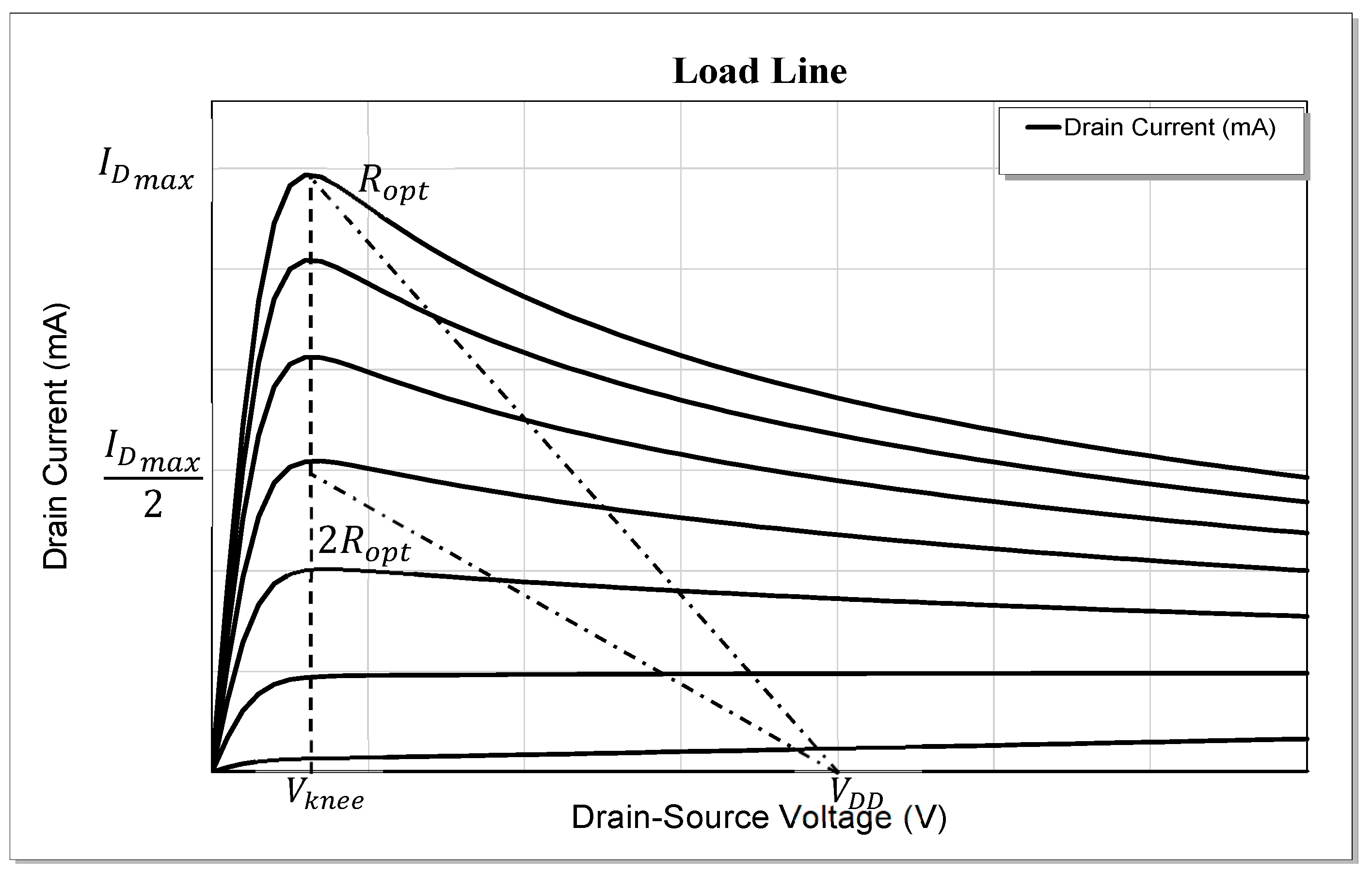

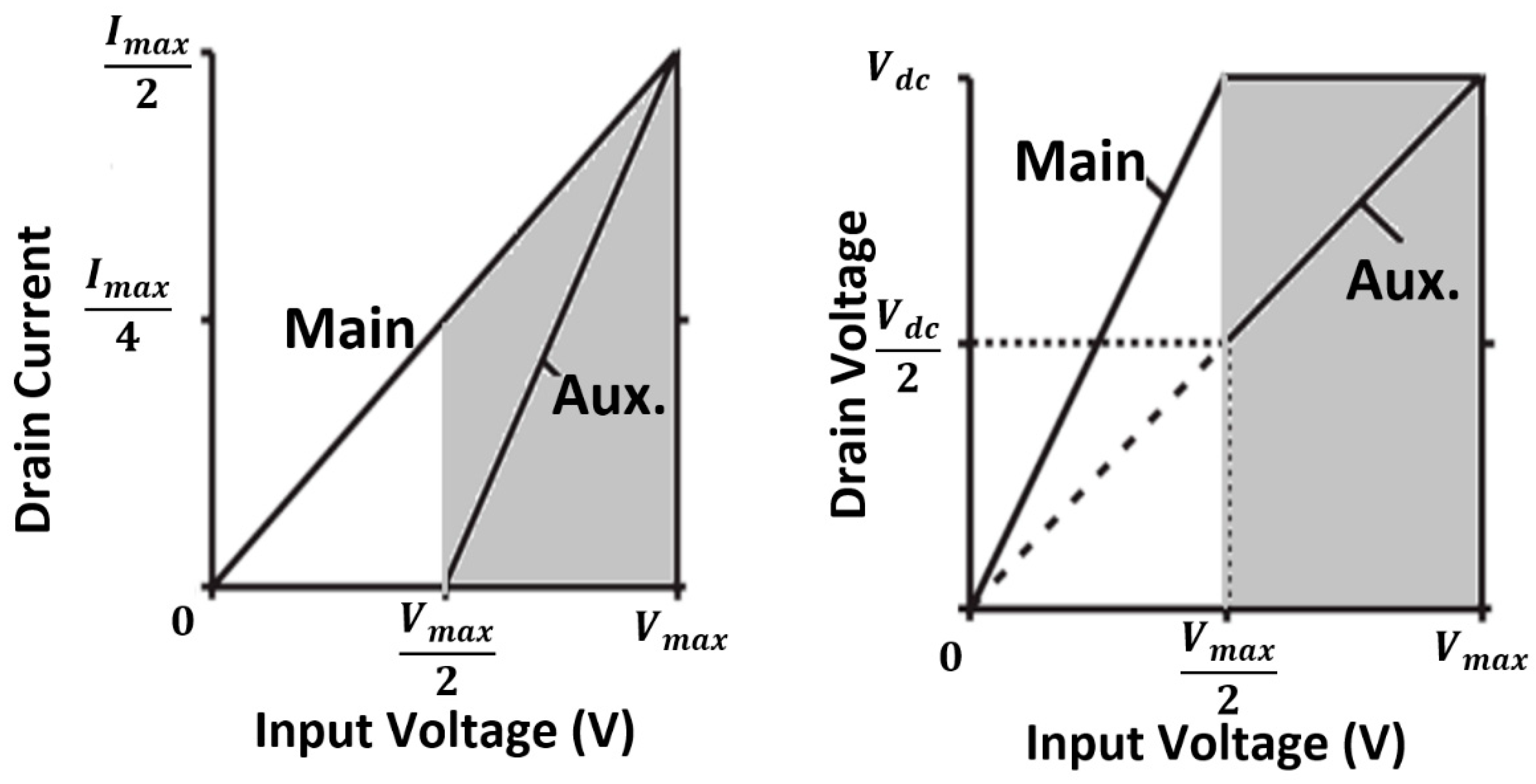
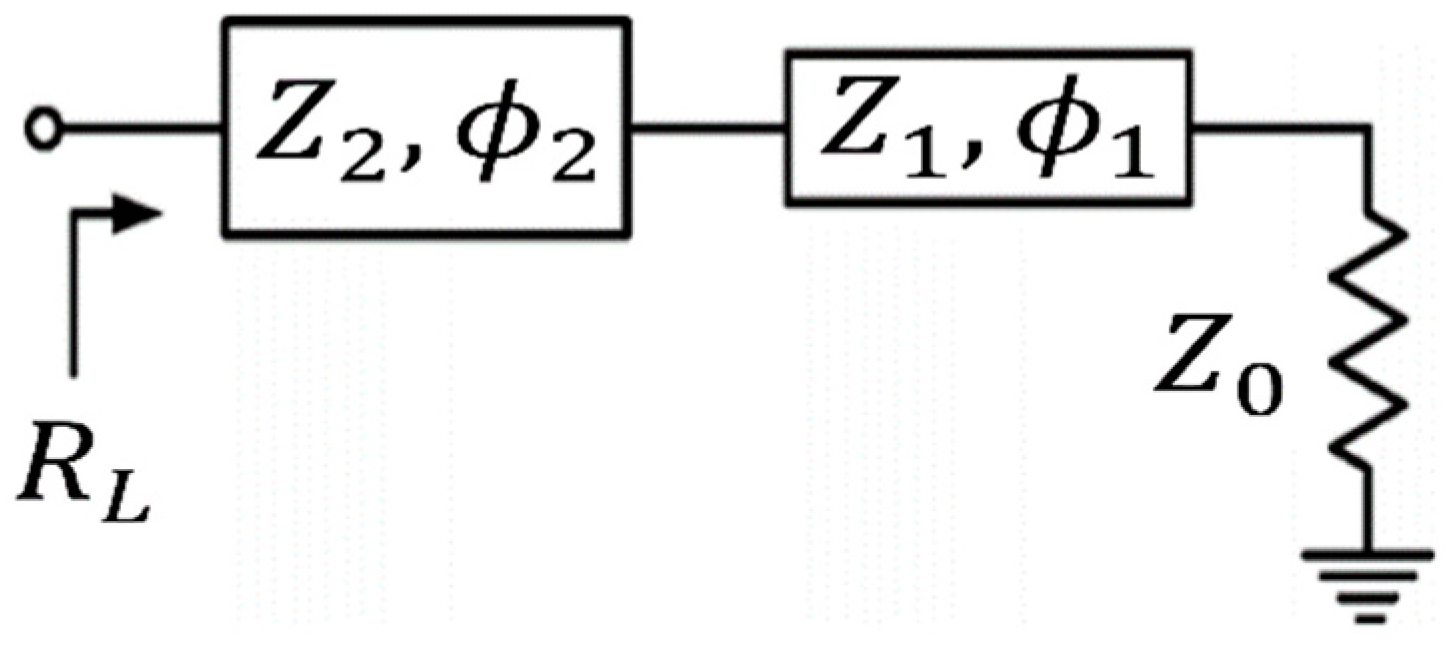
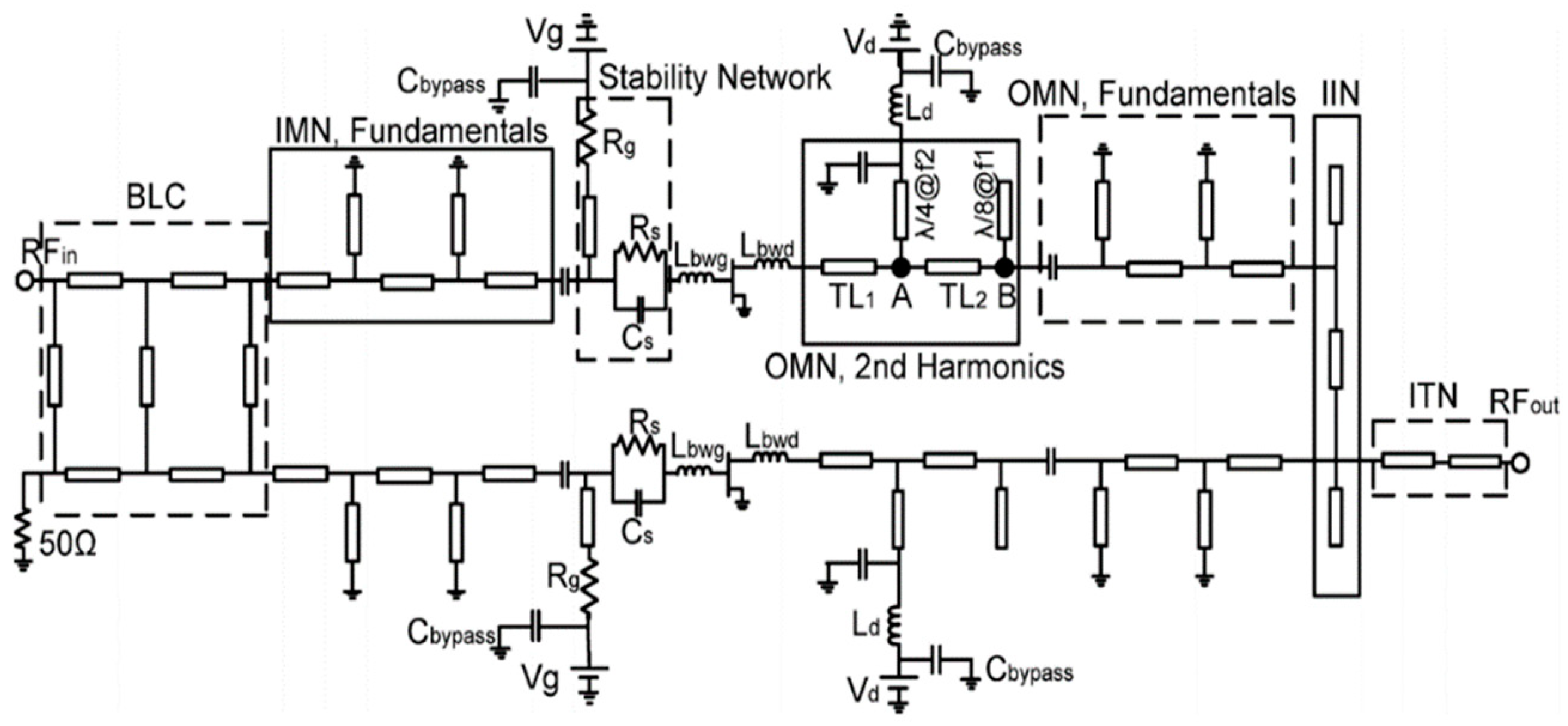
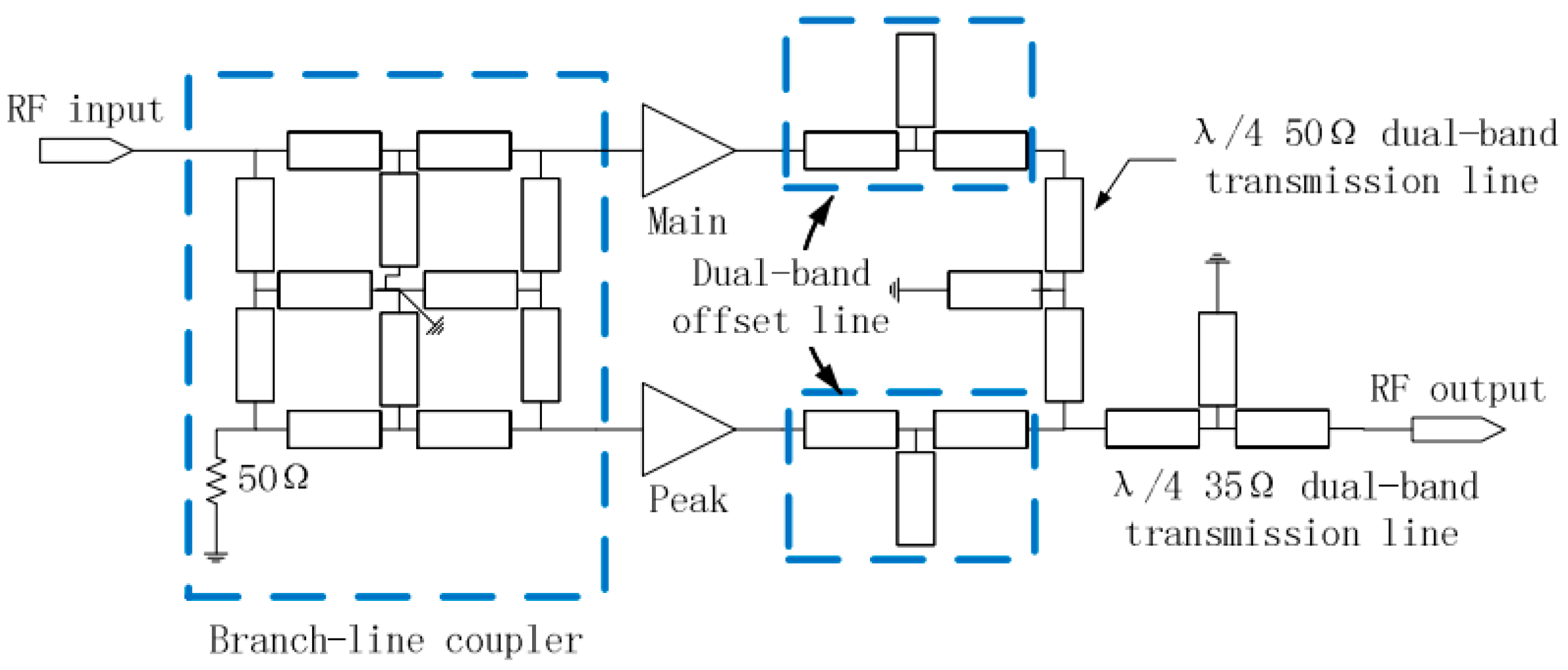
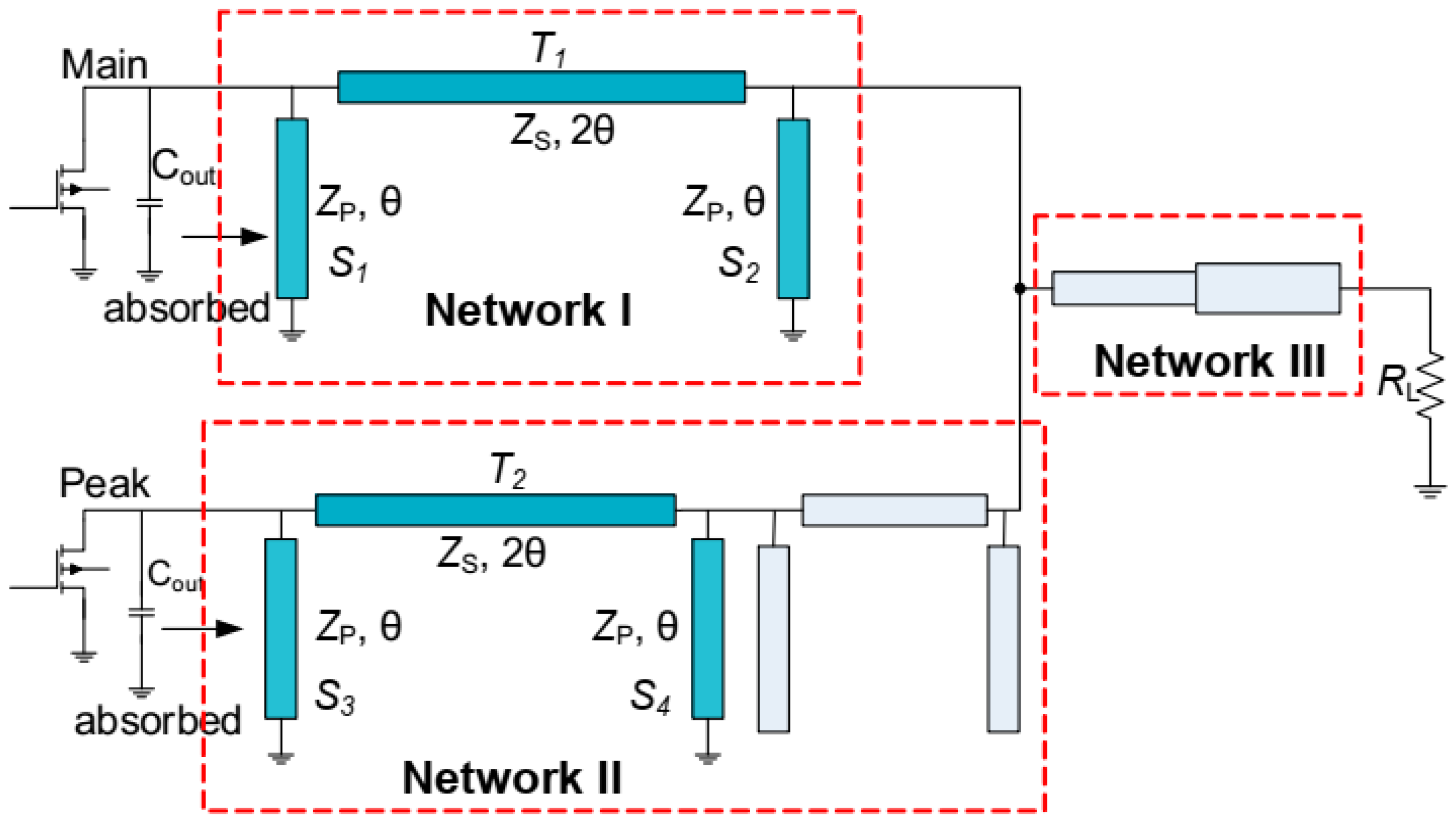

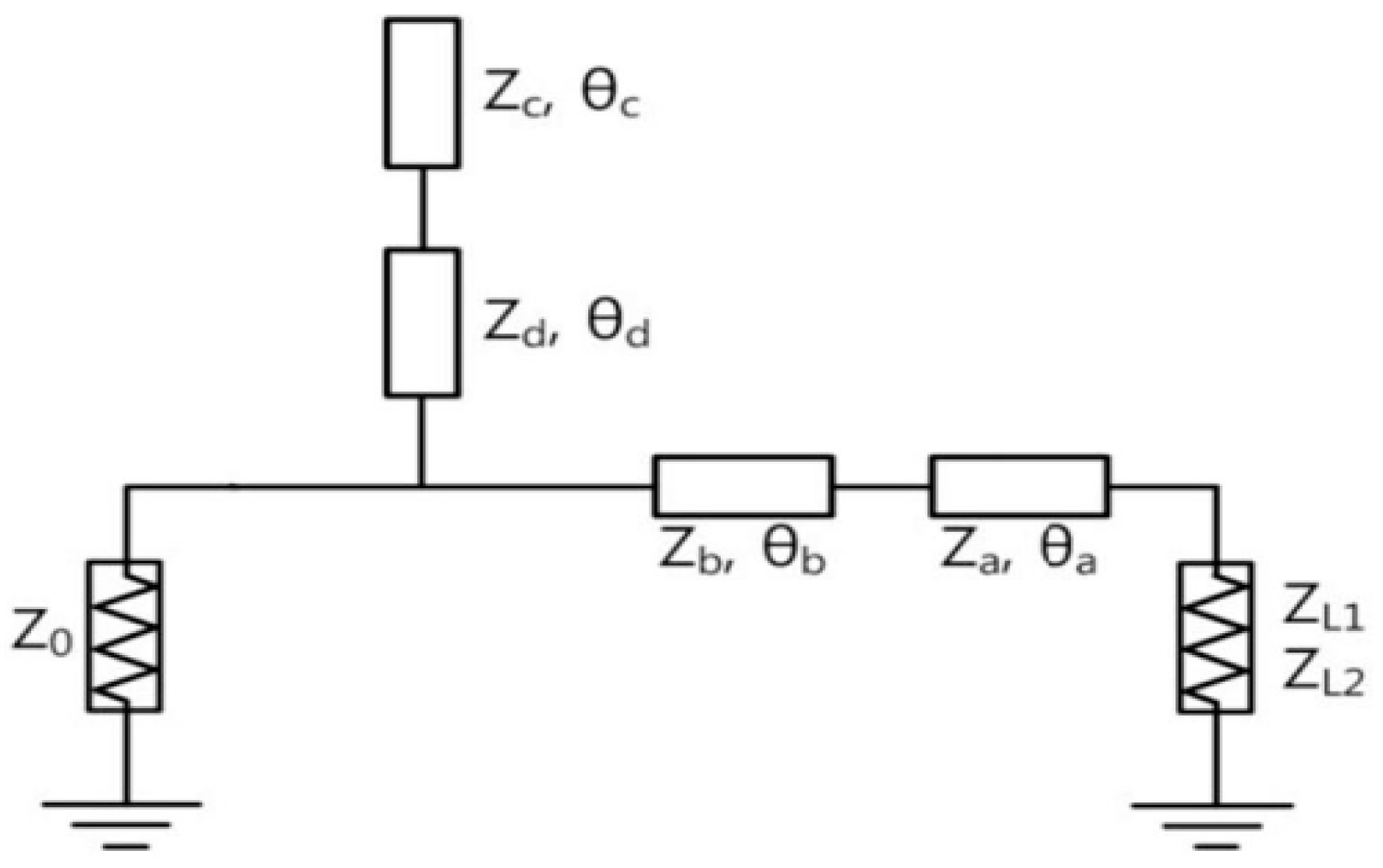
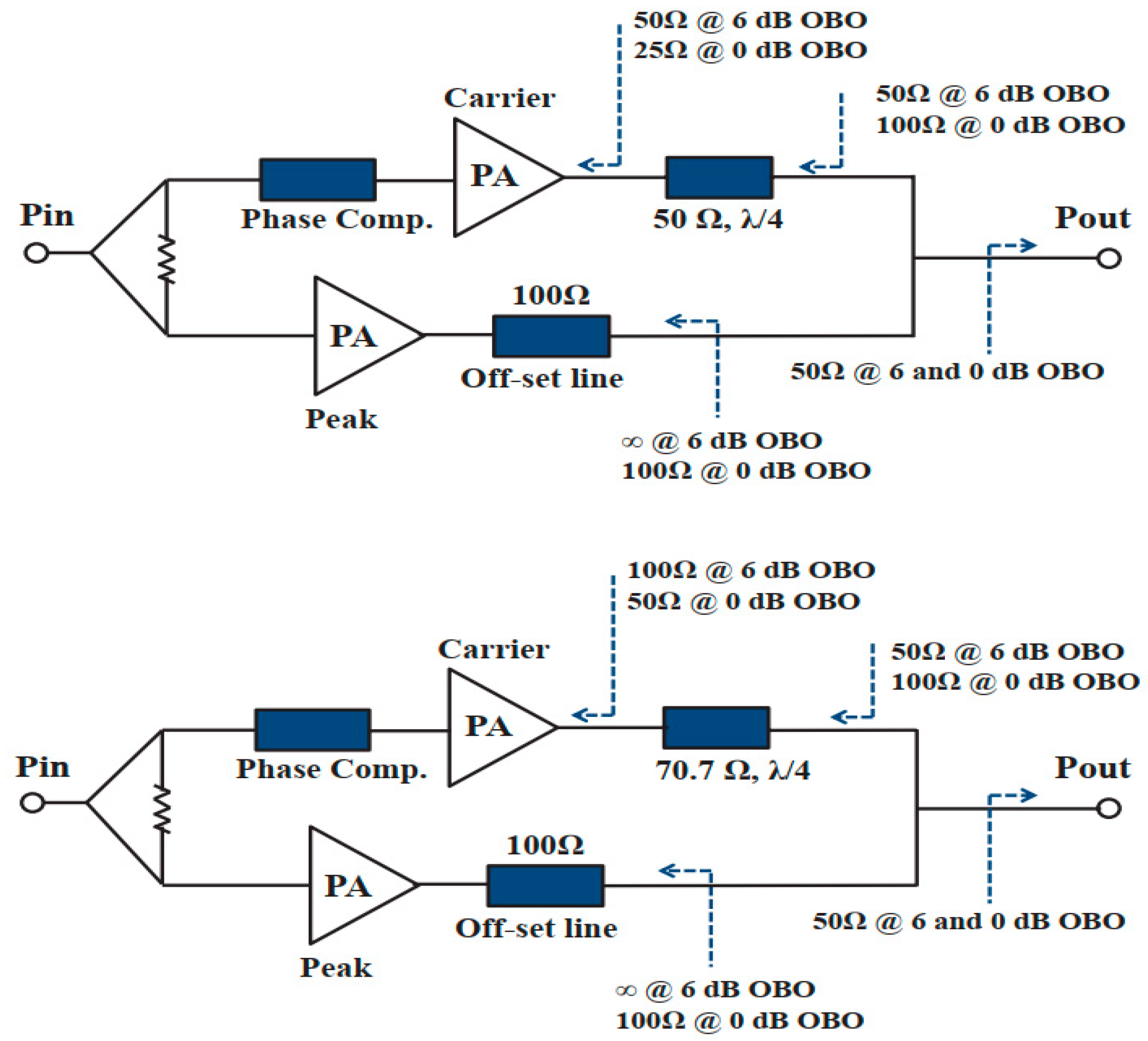
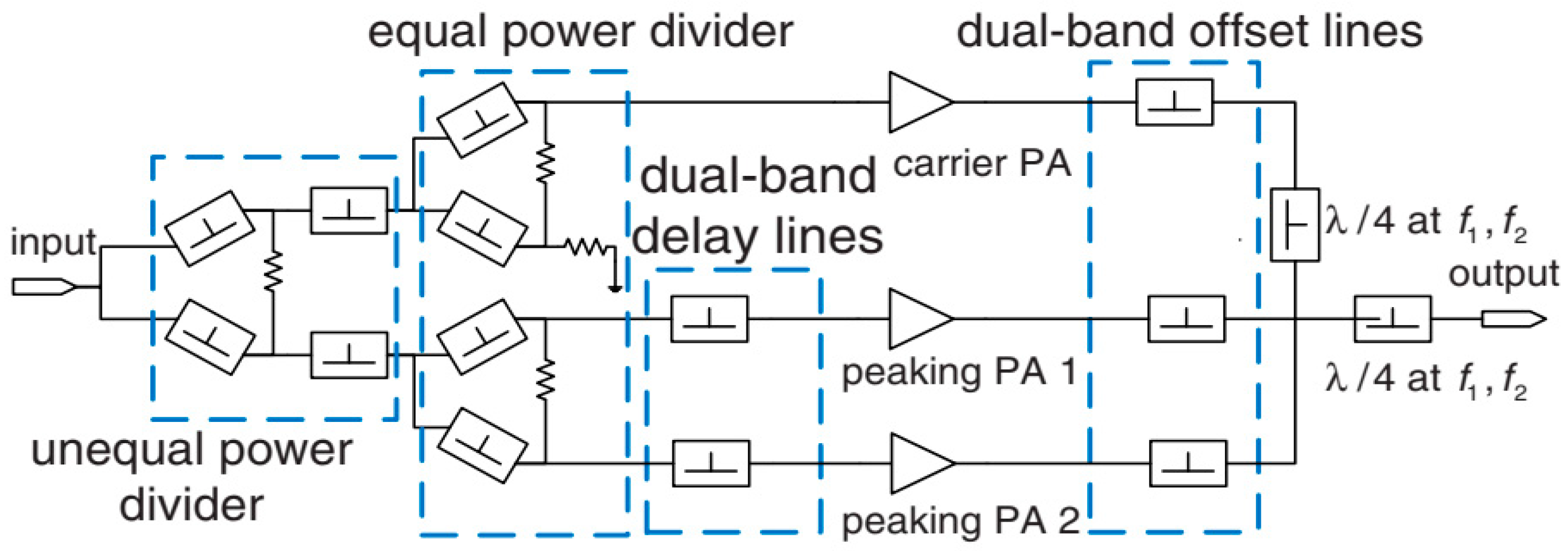
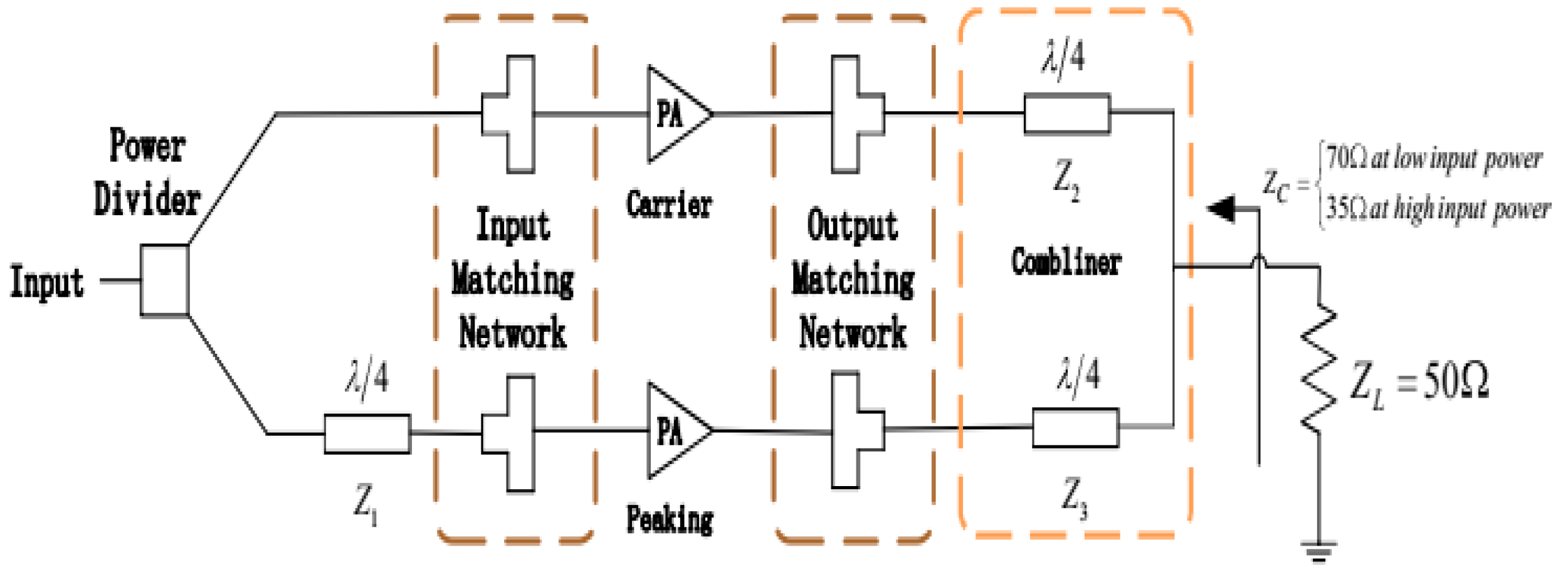
| - | Dual-Band | Single Band | |
|---|---|---|---|
| T-Topology | Π-Topology | Both | |
| Phase | −90° | −90° | 90° |
| Phase | +90° | −90° | |
| Reference | Lower Band | Upper Band | Test | |||||||||
|---|---|---|---|---|---|---|---|---|---|---|---|---|
| Frequency (GHz) | PPeak (dBm) | Efficiency @ PPeak % | Back-Off dB | Efficiency @OBO % | Frequency (GHz) | PPeak (dBm) | Efficiency @ PPeak % | Back-Off dB | Efficiency @OBO % | Signal Type | Signal Bandwidth | |
| [17] | 0.85 | 28.9 | 36.8 * | 6 | 29.9 | 1.7 | 27 | 25.4 * | 6 | 16.8 * | 12-subcarrier NB-IoT/64-QAM/256-QAM WLAN | 12 * 180k / 20 MHz |
| [18] | 2.15 | 47.3 | NA | 6 | 52 | 3.4 | 47 | NA | 6 | 51 | WCDMA/LTE | 20 MHz |
| [25] | 1.8 | 43 | 64 * | 6 | 60 * | 2.4 | 43 | 54 * | 6 | 44 | CW/WCDMA/LTE | − / 10 MHz |
| [7] | 0.9 | 41.9 | NA | 5 | 39.8 | 2 | 41.2 | NA | 5 | 41.4 | CW | - |
| [29] | 2.14 | 39 | 50 | 6 | 45 | 3.5 | NA | NA | NA | NA | CW | - |
| [64] | 0.88 | 41 | 40 * | 6 | 33 * | 1.96 | 40 | 38 * | 6 | 30 * | CW | - |
| [22] | 2 | 42 | NA | 6 | 49 | 2.72 | 42 | NA | 6 | 44 | CW/WCDMA/LTE | − / 5 MHz |
| [21] | 2.1 | 50 | NA | 6 | 47 * | 2.2 | 50 | NA | 6 | 47 * | CW/WCDMA | − / 5 MHz |
| [43] | 0.9 | 46 | 66 | 9 | 65 | 2.15 | 46 | 56 | 9 | 46 | CW | - |
| [23] | 0.92 | 41.5 | NA | 7 | 33 * | 1.99 | 41 | NA | 8 | 29 * | CW | - |
| [31] | 2.14 | 45.5 | NA | 6.5 | 45 | 2.655 | 45.5 | NA | 6.5 | 40 | WCDMA | 5 MHz |
| [44] | 0.85 | 43 | 47.5 * | 6 | 45 * | 2.33 | 42.5 | 32 * | 6 | 41 * | CW/LTE1/LTE2 | − / 10 MHz / 15 MHz |
| [46] | 0.75 | 43 | NA | 9.4 | 42 * | 0.9 | 43 | NA | 9.4 | 72 * | CW/WCDMA/LTE | − / 15 MHz |
| [19] | 0.6 | 38.5 | 65 | 6 | 50 | 1 | 40.5 | 57 | 6 | 37 | CW | - |
| [41] | 1.7 | 45 | NA | 7 | 51 | 2.4 | 45 | NA | 9 | 45.5 | CW/WCDMA/WiMAX | −/ 3.84 MHz / 5 MHz |
| [30] | 1.9 | 36.8 | NA | 6.8 | 50.1 | 2.6 | 36.8 | NA | 6.8 | 50.1 | LTE1/LTE2 | 10 MHz / 15 MHz |
| [35] | 2.3 | 42.5 | NA | 7.2 | 30* | 2.7 | 42.5 | NA | 7.2 | 44.2 * | CW/LTE | − / 10 MHz |
| [34] | 0.6 | 40 | 76.3 | 6 | 54.9 | 1 | 40.2 | 54 | 6 | 38 | CW | - |
| [65] | 1.8 | 44 | 72 | 6 | 63 | 2.6 | 44 | 60 | 6 | 51 | CW/LTE | − /20 MHz |
| [52] | 2.02 | 43.9 | 62.1 | 6 | 51.1 | 2.63 | 44.6 | 71.4 | 6 | 53.3 | CW | - |
| [55] | 0.85 | 44.6 | 58 | 9 | 58 | 2.1 | 44.2 | 68 | 9 | 68 | CW | - |
© 2019 by the authors. Licensee MDPI, Basel, Switzerland. This article is an open access article distributed under the terms and conditions of the Creative Commons Attribution (CC BY) license (http://creativecommons.org/licenses/by/4.0/).
Share and Cite
Abdulkhaleq, A.M.; Yahya, M.A.; McEwan, N.; Rayit, A.; Abd-Alhameed, R.A.; Ojaroudi Parchin, N.; Al-Yasir, Y.I.A.; Noras, J. Recent Developments of Dual-Band Doherty Power Amplifiers for Upcoming Mobile Communications Systems. Electronics 2019, 8, 638. https://doi.org/10.3390/electronics8060638
Abdulkhaleq AM, Yahya MA, McEwan N, Rayit A, Abd-Alhameed RA, Ojaroudi Parchin N, Al-Yasir YIA, Noras J. Recent Developments of Dual-Band Doherty Power Amplifiers for Upcoming Mobile Communications Systems. Electronics. 2019; 8(6):638. https://doi.org/10.3390/electronics8060638
Chicago/Turabian StyleAbdulkhaleq, Ahmed M., Maan A. Yahya, Neil McEwan, Ashwain Rayit, Raed A. Abd-Alhameed, Naser Ojaroudi Parchin, Yasir I. A. Al-Yasir, and James Noras. 2019. "Recent Developments of Dual-Band Doherty Power Amplifiers for Upcoming Mobile Communications Systems" Electronics 8, no. 6: 638. https://doi.org/10.3390/electronics8060638
APA StyleAbdulkhaleq, A. M., Yahya, M. A., McEwan, N., Rayit, A., Abd-Alhameed, R. A., Ojaroudi Parchin, N., Al-Yasir, Y. I. A., & Noras, J. (2019). Recent Developments of Dual-Band Doherty Power Amplifiers for Upcoming Mobile Communications Systems. Electronics, 8(6), 638. https://doi.org/10.3390/electronics8060638









